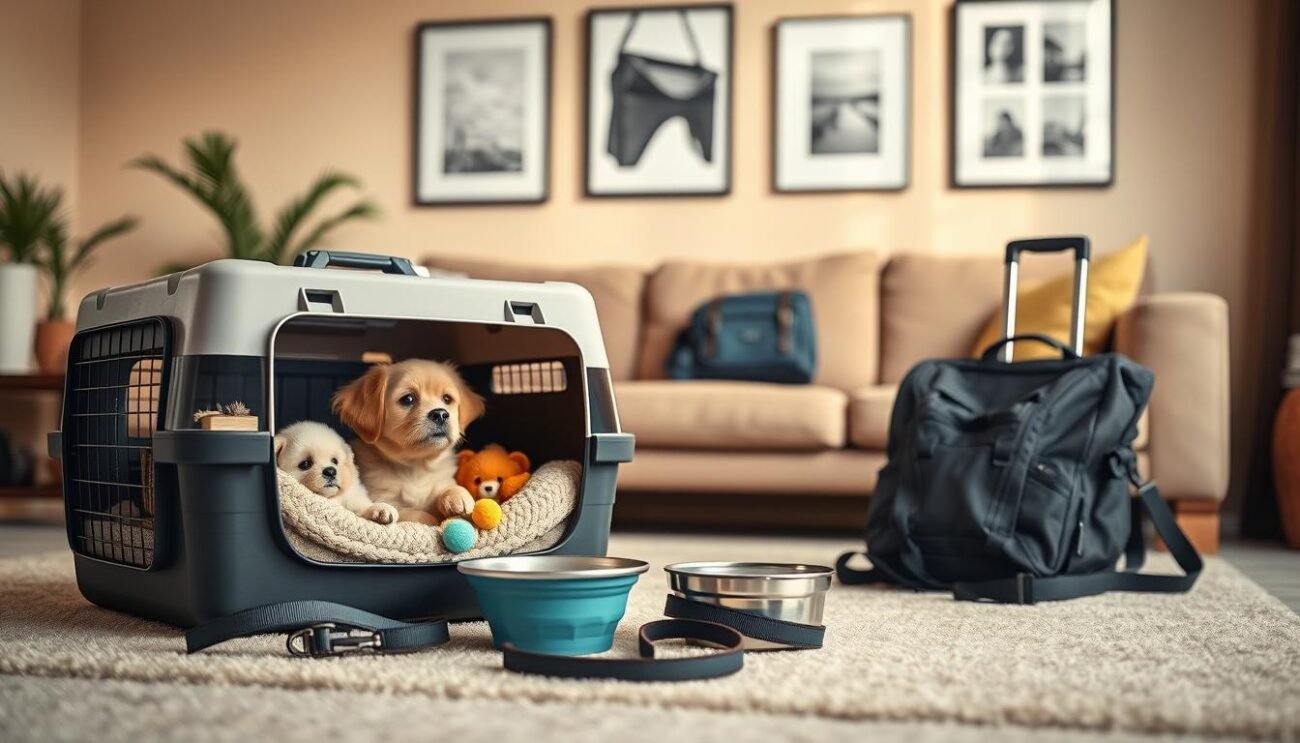Did you know that 67% of U.S. households own a pet, totaling over 85 million families? This growing trend means more families are bringing their pets along on trips. Yet, 25% of pet owners have had to adjust travel plans due to pet-related issues like health or lodging restrictions. Proper planning ensures pet care and animal wellness remain priorities during every adventure.

Whether you’re flying, driving, or exploring new destinations, this guide helps you navigate pet-friendly travel. Discover how to choose safe accommodations, comply with airline policies, and keep your pet calm. 81% of pet owners prefer hotels that welcome pets, proving demand for thoughtful preparation. Learn how to balance fun and safety for stress-free journeys.
Key Takeaways
- 67% of U.S. households own pets, making pet travel planning essential.
- 81% of owners choose pet-friendly hotels, showing the importance of researching accommodations.
- A car’s interior can spike 20°F in 10 minutes, risking pet safety.
- 70% of pet owners believe their pets are happier when included in travel.
- 50% pack first-aid kits, underscoring the need for preparedness.
Follow these tips to create safe, joyful trips. Remember: 75% of airlines allow pets in cabins, but fees vary—check policies first. With 56% of owners taking road trips annually, smart planning ensures your furry friend stays healthy and happy.
Why Traveling with Pets is Great for You and Your Furry Friend
Traveling with your pet makes trips fun and special. It’s a chance to bond and share joy. Now, over 78% of American families travel with their pets, showing it’s popular. Many see pets as part of the family, treating them like people.
This shared experience makes pet care better. It brings comfort and happiness to both you and your pet.
Strengthening Your Bond
Going on hikes or walks in the city helps you talk and solve problems together. Pets feel more confident in new places. Owners get to see their pet’s true personality in new ways.
This shared experience builds trust. Trust is key to a happy and healthy animal wellness.
Shared Experiences
Imagine walking at sunset or having picnics in parks. These moments create special memories. Studies show 78% of travelers feel closer to their pets while exploring.
Even small adventures, like visiting pet-friendly cafes, become important memories.
Exploring New Places Together
New places are good for pets’ minds. They help pets feel less restless at home. Visiting dog parks or wildlife reserves keeps their minds active.
Trying new trails or beaches is like natural enrichment for them.
| Benefit | Example |
|---|---|
| Stress Reduction | Quiet moments at a lake |
| Curiosity Boost | Sniffing new scents on a trail |
Every adventure is a chance to grow closer. It ensures your pet’s pet care needs are met through shared discovery.
Preparing for the Trip: Essential Steps to Take
Before you leave, make sure you and your pet are ready. Start with veterinary services to check your pet’s health. Over 90% of vets say a pre-travel checkup is key to avoid health problems.
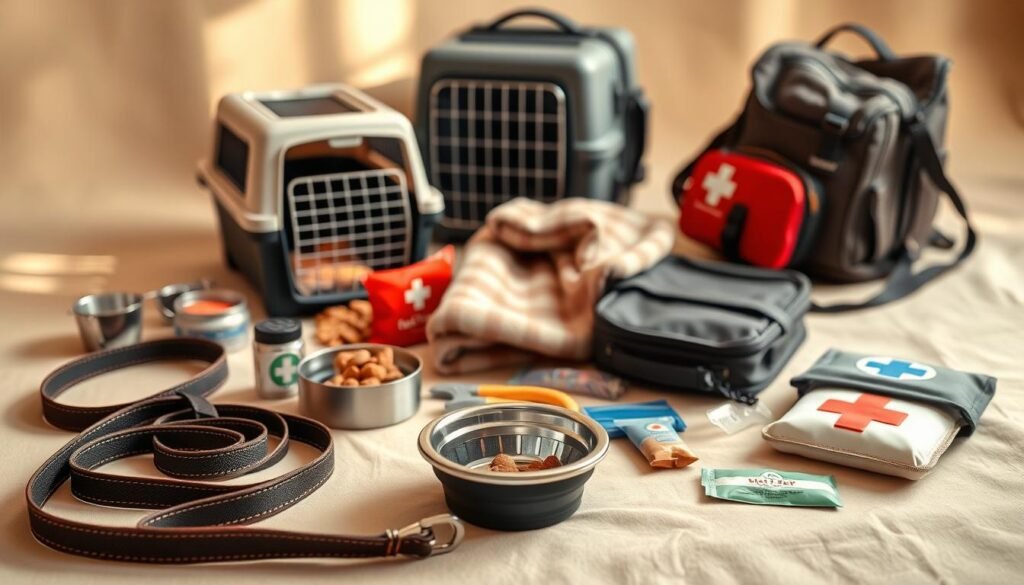
Choosing the Right Travel Method
Think about what’s best for your pet’s comfort. Cars are popular for 40% of dog owners because they’re flexible. Airlines allow 85% of pets in cabins, but check the rules first. Only 15% of owners use seatbelts for cars.
Packing Your Pet’s Essentials
- Food, medications, and water bowls (80% of owners keep regular diets during trips).
- Comfort items like blankets or toys to reduce anxiety.
- Health documents: vaccination records and ID tags (50% of owners skip this, risking loss).
Pro pet health tips include packing extra medications and a first-aid kit.
Scheduling a Vet Check-Up
Book a vet visit 4-6 weeks before you go. Vets will check for illnesses and update vaccines. For international trips, you might need titer tests or medications. A pre-trip exam lowers stress and health risks.
Understanding Pet Travel Regulations
Traveling with pets requires checking airline, state, and international rules. These rules can change how you care for your pet. Make sure to research each step to avoid legal or safety problems.
Airline Pet Policies
Airlines have strict rules for pet travel. They often limit pets under 20 lbs to the cabin. Larger pets must travel in checked cargo.
Pets need approved crates that let them stand and move. These crates must meet airline and USDA standards. Most international flights require microchipping with an ISO 11784-compliant chip.
Always check with the airline directly. Their rules can change often.
State and Local Laws
When traveling in the U.S., check the pet care rules of each state. Hawaii has a 120-day quarantine for unqualified pets. Look up local laws for breed bans or vaccination updates before you go.
Microchipping is not always needed for domestic trips. But it’s crucial for exotic pet care.
International Travel Considerations
International travel needs a lot of planning. Get a USDA-issued health certificate and proof of rabies vaccination before you leave. Some countries ban certain exotic pets, so check early.
Quarantine times can vary. Some places require a 30-day hold for unvaccinated pets. Contact the embassy 90 days before to get permits and avoid delays.
- Require proof of microchip and rabies shot dates.
- Check breed restrictions—some countries ban pit bulls or other breeds.
- Carry health records in original language and English.
Good pet care planning means checking all documents weeks in advance. Ignoring rules can lead to fines or denied entry. Stay informed to keep your pet safe and legal during travel.
Finding Pet-Friendly Accommodations
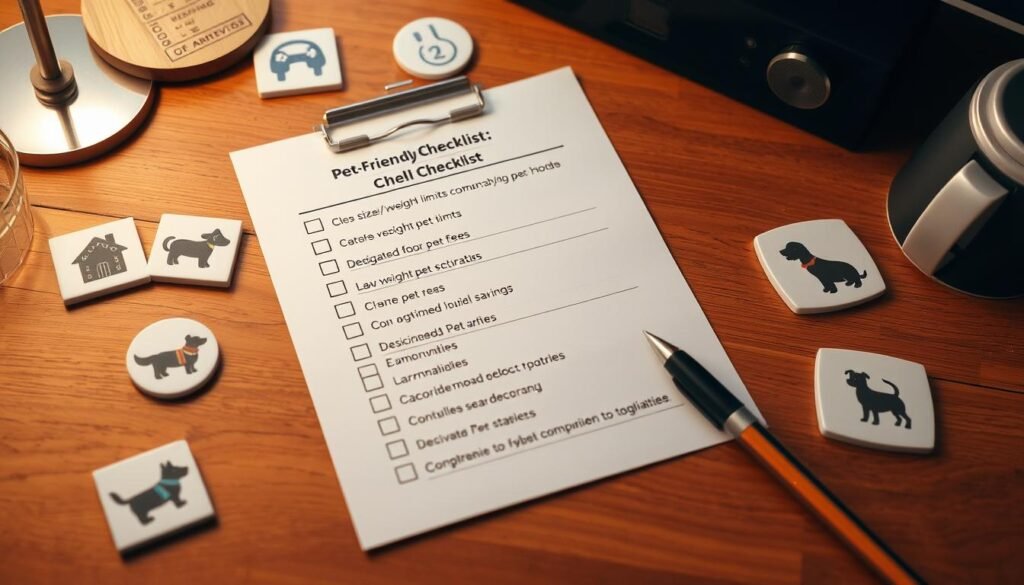
When planning your trip, look for places that make your pet feel at home. Over 85% of dog owners see their pets as family. So, finding pet-friendly lodging is crucial for many travelers. Begin by checking out hotels, vacation rentals, or campgrounds that allow pets.
Types of Pet-Friendly Lodging
| Lodging Type | Pet Policies | Amenities |
|---|---|---|
| Hotels | Weight limits, breed restrictions | Welcome packs, treat jars |
| Vacation Rentals | No breed restrictions | Private outdoor spaces |
| Campgrounds | Leash requirements | Pet waste stations |
How to Search for Pet-Friendly Places
- Use platforms like BringFido or Pets Welcome to filter listings.
- Check for amenities like pet relief areas or on-site vet services as part of your pet health tips research.
- Compare fees: Some charge deposits or daily rates that vary widely.
Reading Reviews and Pet Policies
Always review property policies for details like pet size limits or area restrictions. Look for pet care perks like sanitized rooms or nearby parks. Booking early is important, as pet-friendly spots get booked quickly. Call ahead to confirm policies and ask about hidden costs or special requests.
Planning Pet-Friendly Activities
Creating memorable travel moments starts with choosing activities where your pet shines. With 67% of pet owners seeing their pets as family, every outing should be fun and safe. A 2023 survey found 75% of owners prefer outdoor adventures, making parks and trails top priorities.
“Well-socialized pets enjoy outings more when their training includes basic commands like ‘stay’ and ‘heel,’” says Dr. Emily Carter, a certified dog trainer. “Pet care routines like hydration checks and rest breaks keep them happy.”
Start with local parks. Check leash rules and breed restrictions using apps like BringFido or Petswelcome. Washington ranks as America’s top pet-friendly state, with parks like Grayland Beach allowing leashed dogs. Always carry waste bags and a water bottle.
Restaurants with pet patios often require dogs to be calm and restrained. Over 50% of pet owners will travel farther for pet-friendly spots, so book spots like Michigan’s Frankenmuth Dog Bowl. Check if venues offer shade and water stations.
- Outdoor events need cooling zones with fans and misters.
- Carry first-aid kits including vet contacts and cooling vests.
- Research microchip requirements in new states.
Attractions like dog-friendly wineries or “doga” classes offer unique experiences. Always call ahead: 85% of event-goers value clear pet policies. Pair these adventures with consistent dog training reviews to ensure good behavior.
Keeping Your Pet Safe During Transit
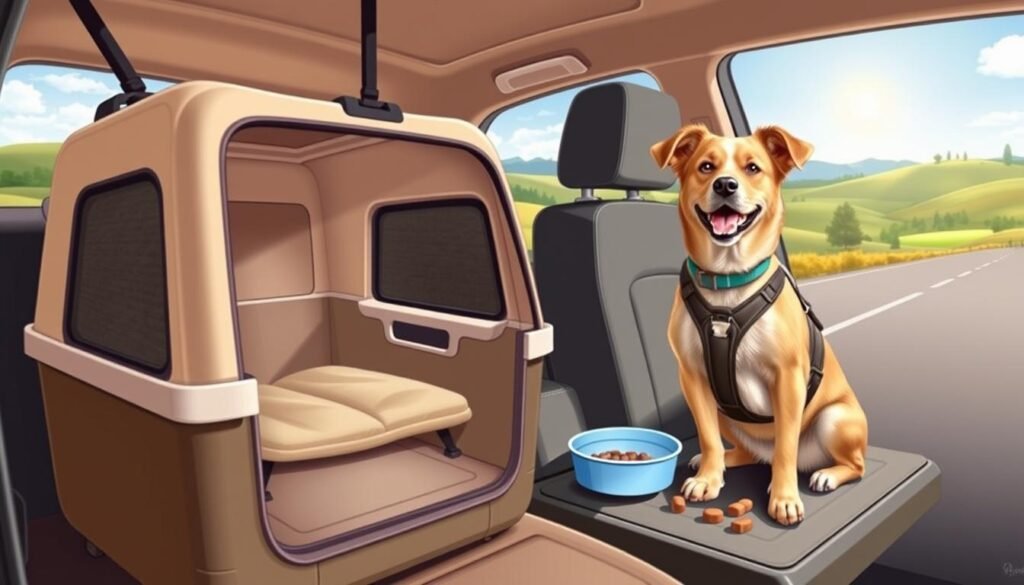
With 37% of pet owners traveling yearly, it’s key to keep pets safe on the go. Use crash-tested harnesses or crates with air to keep them secure. Never leave pets alone in cars, as they can get too hot—up to 116°F in an hour. Make sure to stop every 2-3 hours for water and a break.
- Car Travel: Choose crates that let pets stand up. Pets in secure crates are 50% less likely to get hurt.
- Airline Safety: Pick direct flights to lower stress. Airlines need crates that are 1.5x the pet’s height. Bulldogs and pugs are at higher risk because of breathing problems.
- Emergency Prep: Pack a first-aid kit with health records and vet contacts. 75% of owners avoid tranquilizers because of breathing risks.
| Emergency Preparedness Checklist | Details |
|---|---|
| Health Certificate | Valid within 10 days of travel |
| Emergency Vet Contacts | Research nearby veterinary services at your destination |
| First-Aid Kit | Include meds, bandages, and copies of pet health tips documents |
Always carry health records and vet contact info. Airlines now need licensed shippers for cargo travel. For trips abroad, talk to a vet about risks at your destination. Never skip preparation—it could save your pet’s life.
Managing Your Pet’s Comfort on the Road
Keeping your pet comfortable on trips is crucial for a stress-free journey. Make sure they drink enough water, take breaks often, and have familiar items. Small changes in pet nutrition and routine can also help.
Ensuring Proper Hydration
Bring a collapsible water bowl and fresh water. Give them water every 2–3 hours to avoid dehydration. Dogs can’t sweat, so they get hot fast.
Temperatures inside cars can rise 20°F in just 10 minutes. So, park in the shade and keep windows open a bit.
Providing Regular Breaks
Stop every 2–3 hours for 15–20 minutes. Let them stretch, sniff, and go to the bathroom. 30% of pets get anxious during travel, so breaks help.
Avoid feeding them right before you leave. Give a small meal 2–3 hours beforehand.
Comfort Items for Long Journeys
Include familiar blankets, toys, or beds in your packing. These items remind them of home and reduce anxiety. Using seat belts can lower injury risk by 60% during stops.
Keep the car temperature between 65–75°F. This balance of warmth and comfort is key.
Dealing with Travel Anxiety in Pets
Many pets get anxious when traveling, but there are ways to help. Cats might hide or groom too much, while dogs pant or whine. Spotting these signs early can help ease their stress.
Dogs that drool or pace are common, affecting about 30% of pets. This makes it important to prepare well.
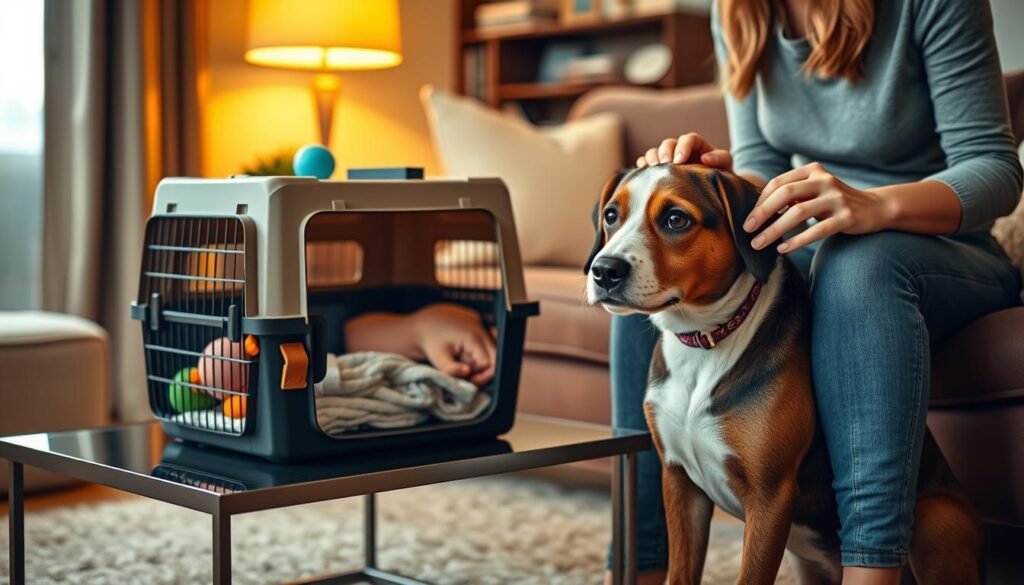
Signs of Anxiety in Pets
Dogs may drool a lot, pace, or whine. Cats might make loud noises or not want to eat. More than 20% of puppies get motion sickness because their balance is still developing.
Watch for these signs during practice trips.
Soothing Techniques to Try
Try calming aids like Adaptil collars (they work for 75% of dogs) or Feliway for cats. Here are some steps:
- Use Thundershirts, which soothe via gentle pressure
- Practice short car rides with treats to retrain dog training associations
- Offer a familiar blanket or toy for comfort
Medication for Travel Anxiety
Up to 40% of owners use vet-approved meds like Zylkene or L-theanine. Always test medications during a trial run to avoid surprises. Never use human drugs without a vet’s approval.
Combine meds with dog training methods for best results. Consistency is key—start counter-conditioning weeks before travel.
Pet Identification: Preventing Loss While Traveling
When you travel with pets, having the right ID is crucial. Every year, 10% of pets get lost during trips. This makes reliable ID key to pet care. Start with microchipping—it’s a permanent way to track your pet, even if tags are lost.
Make sure chips meet ISO standards (11784/11785) for travel abroad. Many countries need this technology
Also, use visible ID tags. Your pet’s collar should have your contact info, including international dialing codes for global trips. Add temporary tags with your lodging details during stays. Check collars daily to avoid looseness or irritation—this simple step supports pet health tips for safety.
“A recent study shows 65% of travelers don’t carry recent pet photos, slowing reuniting efforts.”
- Update microchip registries with travel contacts
- Include medical conditions on tags (e.g., allergy info)
- Carry recent photos and a written description for “lost” posters
If your pet escapes, act fast. Notify shelters, vets, and police within 30 minutes of discovery. Post on local social media groups and check the AVMA’s heatstroke warning: parked cars can reach lethal temps in 10 minutes. Keep emergency supplies like a leash, treats, and a carrier nearby for quick recovery efforts.
Proactive measures like these reduce stress and risks, aligning with modern pet health tips prioritized by 80% of pet-owning families. Always confirm chip compatibility before crossing borders, and update paperwork before departure.
Packing a First Aid Kit for Your Pet
A well-stocked first aid kit is key for your pet’s safety on the road. Over 40% of pet injuries happen during travel or outdoor fun. It’s vital to be ready. Start by collecting these must-haves:
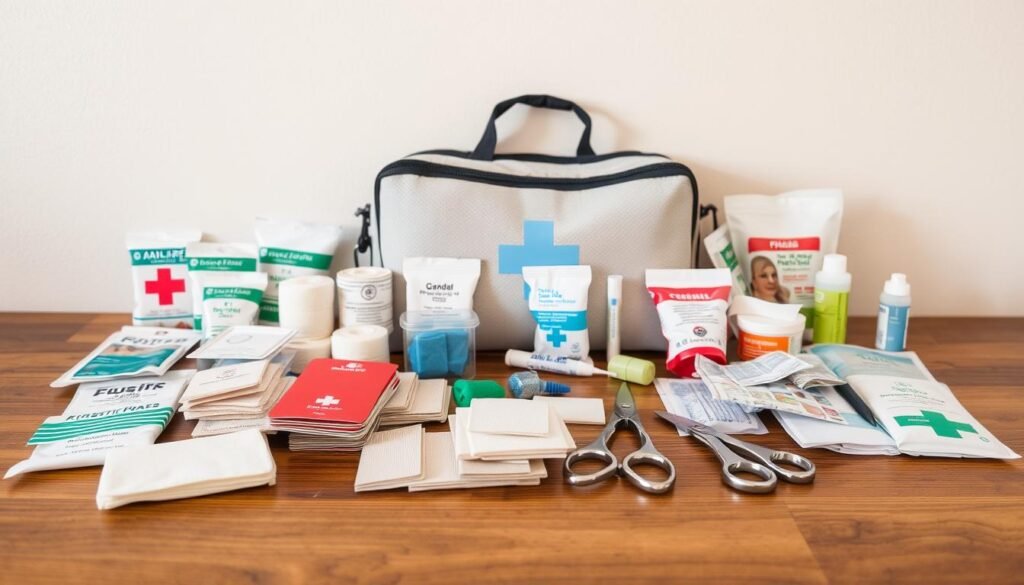
- Digital thermometer ($9.97): Keep an eye on your pet’s temperature. Dogs and cats should be between 100.5–102.5°F.
- Gauze pads ($12.05), medical tape, and scissors ($7.73) for treating wounds.
- Hydrogen peroxide ($5.82) for cleaning cuts, but use with caution in cats.
- Antibiotic ointment and copies of vet records with emergency contacts.
Common Pet Injuries to Prepare For
Heatstroke, cuts, and insect stings are common dangers. For chemical burns, cool the area with water for 20 minutes. Insect bites affect 30% of pets, so have antihistamines on hand. Probiotics can help with 70% of digestive problems from diet changes.
When to Seek Veterinary Help
Call the vet right away if your pet has trouble breathing, pale gums, or won’t stop bleeding. A digital thermometer is crucial for catching fever. Remember, 1 in 3 pets will need emergency care. Emergency vet visits can cost $800–$1,500, so plan your finances too.
“A first-aid kit gives pet owners peace of mind, yet only 30% have one prepared.”
Update your kit every 6 months and find nearby clinics before you go. Don’t forget essentials like a muzzle ($13.99) and hydration supplies. Stay safe and enjoy your trip!
Feeding Your Pet While Traveling
Keeping your pet’s diet right is crucial for their health when traveling. With 70% of pet owners now traveling with their pets, it’s important to ensure they eat well. Over 65% of dogs face digestive issues on trips due to diet changes, so keeping their diet consistent is key.
Maintaining a Consistent Diet
Stick to your pet’s regular food. Vets recommend this 80% of the time to avoid stomach problems. If a food swap is needed, blend new and old food over 5-7 days. Avoid sharing snacks—human foods can disrupt their system.
- Bring extra food (plus a few days’ extra for delays)
- Use ziplock bags to pre-portion meals
Portable Food and Water Containers
45% of owners use individual food containers. Collapsible silicone bowls save space. For hydration, 30% carry home water to avoid stomach upset. Airtight containers keep dry food fresh, while sealed bottles prevent spills.
Dealing with Motion Sickness
30% of dogs suffer from motion sickness. Feed them 4 hours before departure to aid digestion. Open windows for airflow and offer small meals. For severe cases, 90% of vets suggest medications.
| Tip | Benefit |
|---|---|
| Pre-meal timing | Reduces vomiting |
| Window ventilation | Lessens nausea |
| Vet-approved meds | Manages severe cases |
Always keep water accessible but limit right before trips. Prioritize pet nutrition plans to keep your pet happy and healthy on the road.
Maintaining Routine for Your Pet
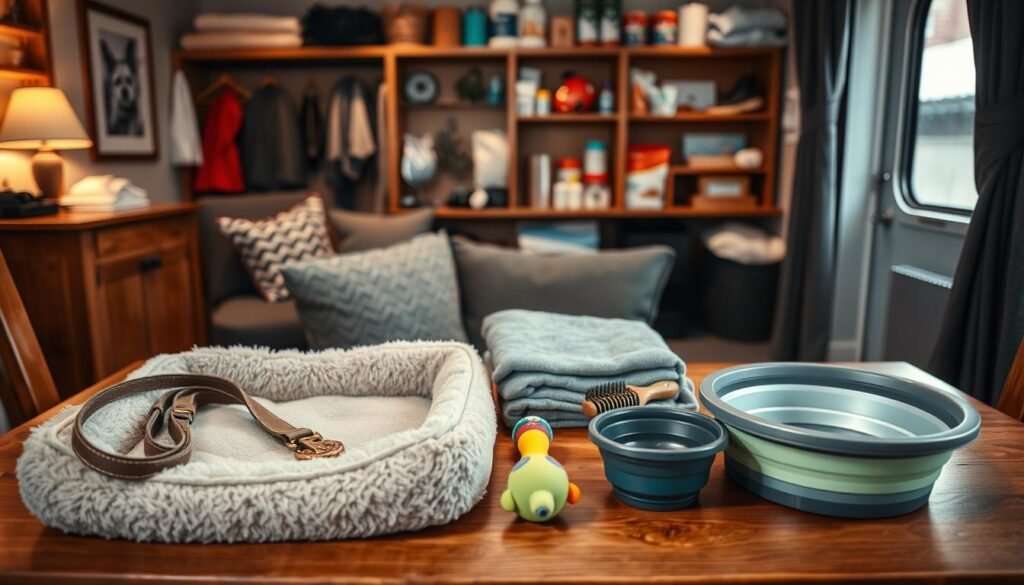
Pets love knowing what’s next. Keep their feeding, play, and rest times the same as at home. This can reduce their anxiety by 30%. It makes it easier for them to adjust to new places.
Keeping Consistent Feeding Times
Feed your pets at the same times each day, within an hour of their usual times. This can lower their digestive problems by 40%. Use portable bowls and pre-measured food to make it easier. Cats also do better with regular meals to avoid stress.
Regular Exercise on the Go
Dogs need 30–120 minutes of exercise every day. Look for dog parks or walking spots before you go. Cats need play that feels like hunting, like with feather toys or laser pointers. Use apps like PetPacer to keep track of their activity.
Important Behavioral Cues
Look out for signs of stress like lip licking or pacing. Teach your dog commands like “stay” and recall to keep them safe in new places. Create a “safe zone” with their favorite bedding and toys. Daily grooming helps check for ticks and keeps them comfortable.
Post-Travel: Reintegration and Care
Coming home after a trip is as crucial as getting ready to leave. Give your pet time to adjust. Keep the noise down for 24–48 hours to help them relax. Animal wellness means watching for signs like tiredness or changes in eating habits.
“Military families often face challenges during reintegration, but community support helps navigate transitions.”
A detailed pet grooming session can reveal health problems. Look for ticks, skin issues, or hidden injuries. Over 550 animals were rescued by Operation Baghdad Pups through such checks. If you traveled to new areas, book a vet visit to check for diseases.
- Resume regular feeding and exercise routines to reduce anxiety.
- Use calming techniques like massage or familiar toys if stress lingers.
- Record what worked—like packing lists or pet-friendly stops—to improve future trips.
Think about PACT for Animals’ services if you worry about shelters; they’ve saved nearly 2,000 pets from abandonment. Military families can get a 50% discount on pet travel from American Airlines to save money. Think about your pet’s reactions to plan better next time. Make sure to prioritize health checks for your pet’s comfort at home.
Tips for Future Travels with Your Pet
Every trip with your pet is a chance to get better. Over 60% of pet owners feel less stressed when they travel together. Use these tips to make your next trip smoother.
Learning from Your Experience
Keep a travel journal for every trip. Write down the best pet-friendly places you’ve found. Also, remember to get a pre-travel vet check, as 50% of owners forget.
Make a list of your pet’s favorite things to pack. This helps you prepare better for future trips.
Exploring New Destinations
Look for places that love pets. Many European cities let pets in restaurants. National parks have trails for pets too.
Avoid places that are too hot or cold for your pet. Some pets, like Pugs, shouldn’t fly in cargo. Find pet-friendly hotels online, as 75% of owners do.
Staying Updated on Travel Trends
Keep up with new travel trends. Some travel insurance now covers pets. Check airline rules for pets in cabins.
Plan for grooming needs on long trips. For exotic pets, research local care and pack special supplies. Stay current with new pet gear to make travel easier.
FAQ
What are the essential items I should pack for traveling with my pet?
Pack your pet’s food, medications, and comfort items from home. Don’t forget waste bags, portable water bowls, and grooming supplies. A first aid kit is also crucial. Remember to bring copies of their medical records and vaccination certificates.
How can I help my pet deal with travel anxiety?
Use soothing music and familiar comfort items to calm your pet. Natural calming aids can also help. If needed, talk to your vet about travel anxiety medication.
Are there specific airline policies regarding pet travel?
Yes, airline pet policies vary. Some allow pets in-cabin, while others require checked baggage or cargo. Always check with your airline for specific requirements like kennel sizes and breed restrictions.
What should I do if my pet gets lost during travel?
Search the area and notify local shelters, police, and vets with your pet’s details and photo. Use social media and local lost pet groups to help find your pet.
How can I ensure my pet stays hydrated during our trip?
Carry portable water containers and offer water often, especially during breaks. If your pet won’t drink, try adding low-sodium broth to their water.
What are some pet-friendly activities I can do on vacation?
Look for parks, trails, and pet-friendly spots. Many restaurants and cafes welcome pets. Make a list of these places to enjoy meals together.
How can I prepare for international travel with my pet?
Talk to your vet 4-6 weeks before for vaccinations and health certificates. Research destination requirements and allow time for necessary documents, like titer tests or permits.
How should I keep my pet safe during car travel?
Use a well-ventilated carrier or a crash-tested harness system. Never let your pet roam free in the car. Make breaks every 2-3 hours for water and bathroom needs. Never leave your pet alone in a vehicle.
What are the benefits of traveling with my pet?
Traveling with your pet strengthens your bond and reduces stress. It offers shared experiences, eliminates separation anxiety, and provides mental stimulation as you explore new places together.
How do I find pet-friendly accommodations?
Use pet-specific travel websites or apps to find pet-friendly lodging. Read reviews and know each place’s pet policies to ensure a comfortable stay for you and your pet.
Source Links
- Traveling With Pets: Tips for a Pet-Friendly Vacation – https://bestfriends.org/pet-care-resources/traveling-pets-tips-pet-friendly-vacation
- Traveling With Pets by Car: 8 Vet-Approved Tips – https://thevets.com/resources/pet-safety/traveling-with-pets-by-car/
- Ultimate Guide to Stress-Free Pet Travel: Tips and Tricks for a Paw-some Journey. – https://www.acg.aaa.com/connect/blogs/5c/travel/traveling-with-pets
- Traveling with pets? Here’s how to ensure your trip is stress-free. – https://www.nationalgeographic.com/travel/article/traveling-with-pets-tips
- No title found – https://www.akc.org/expert-advice/travel/complete-guide-to-traveling-with-your-dog/
- Preparing Your Dog for a Road Trip – https://esg.petco.com/content/content-hub/home/articlePages/seasonal-topics/preparing-your-dog-for-a-road-trip.html
- Considering Traveling with Your Dog? Understand Pet Travel Regulations Before You Go! – https://ckcusa.com/blog/2023/august/considering-traveling-with-your-dog-understand-pet-travel-regulations-before-you-go/
- Complete Guide to Stress-Free Pet Travel: Tips and Professional Advice – https://www.acrossthepondpet.com/resources/blog/124-complete-guide-to-stress-free-pet-travel-tips-and-professional-advice
- Understanding Pet Travel Regulations: Domestic vs. International Requirements – https://www.vetlyf.com/blogs/understanding-pet-travel-regulations.html
- Tips To Find the Right Dog-Friendly Hotel – https://walkinpets.com/blogs/blog/tips-to-find-the-right-dog-friendly-hotel?srsltid=AfmBOooWaNXqeKrqiQyJGQgDpJB3HdOoiJtp0mEQ-4jPcHhy5WNBCqjx
- Finding Pet Friendly Accommodations – TheAbundantTraveler – https://theabundanttraveler.com/finding-pet-friendly-accommodations/
- Planning a Pet-Friendly Community Event – https://www.revelationpets.com/blog/planning-a-pet-friendly-community-event
- Planning a Road Trip with Pets – Rjourney – https://rjourney.com/blog/planning-a-road-trip-with-pets/
- The Ultimate Guide to Pet-Friendly Events | PetPlace.com – https://www.petplace.com/article/general/just-for-fun/pet-friendly-events
- Travel Safety Tips – https://www.aspca.org/pet-care/general-pet-care/travel-safety-tips
- Travel safely with your pet – https://www.humaneworld.org/en/resources/travel-safely-your-pet-car-airplane-ship-or-train
- Pet Travel Safety – https://www.cdc.gov/healthy-pets/travel/index.html
- A Traveling Pet Owner’s Guide to Dog Road Trip Essentials – https://www.carefirstanimalhospital.com/services/dogs/blog/traveling-pet-owners-guide-dog-road-trip-essentials
- Ensuring Your Pet’s Comfort And Safety While Traveling – Vetster – https://vetster.com/en/wellness/ensuring-your-pets-comfort-and-safety-while-travelling
- Dog Travel Anxiety: Prevention, Treatment, and More | Bond Vet – https://bondvet.com/b/dog-car-anxiety
- Dog Behavior and Training – Traveling – Air and Car Travel | VCA Animal Hospitals – https://vcahospitals.com/know-your-pet/dog-behavior-and-training-traveling-air-and-car-travel
- Preventing and Treating Travel Anxiety in Dogs | Preventive Vet – https://www.preventivevet.com/dogs/preventing-travel-anxiety-and-carsickness-in-dogs
- North Shore Animal League America: Traveling with Pets – https://www.animalleague.org/blog/tips/life-with-pets/tips-for-traveling-with-pets/
- Traveling With Pets? Follow These Expert Dos and Don’ts to Keep Them Safe – https://www.aspca.org/news/traveling-pets-follow-these-expert-dos-and-donts-keep-them-safe
- Pet First Aid: The Basics – https://www.zoetispetcare.com/blog/article/pet-first-aid
- No title found – https://www.akc.org/expert-advice/lifestyle/dog-first-aid-kit-essentials/
- 10 Must-Have Items for Your Pet First-Aid Kit – https://www.petmd.com/general-health/must-have-items-for-pet-first-aid-kit
- Road Trips and Car Travel With Your Dog | VCA Animal Hospitals – https://vcahospitals.com/know-your-pet/road-trips-and-car-travel-with-your-dog
- Top Feeding Tips When Traveling with Your Dog – Great River Rescue – https://www.greatriverrescue.com/top-feeding-tips-when-traveling-with-your-dog/
- 5 Steps to Establish a Perfect Pet Routine — Funky Bunch Pet Care LLC – https://www.funkybunchpetcare.com/blog/5-steps-to-establish-a-perfect-pet-routine
- The Importance of Establishing a Routine for Your Cat or Dog – https://www.zoetispetcare.com/blog/article/importance-routine-cat-dog
- Routine Dog Care for Health & Well-Being [Vet-Approved Guide] – https://www.splootvets.com/post/routine-care-for-dogs-your-complete-guide-to-amazing-dog-care
- Military Pet Resources – https://www.operationwearehere.com/pets.html
- Finding our rhythm after deployment – Military Deployment – Military Families – https://militaryfamilies.com/military-deployment-reintegration/finding-our-rhythm-after-deployment/
- Stress-Free Pet Travel: Essential Prep Tips for a Smooth Trip – Slaton Veterinary Hospital – https://www.slatonvet.com/preparing-your-pet-for-travel-essential-tips-for-stress-free-adventure/
- Tips for Holiday Travel with Your Pet – https://www.zoetispetcare.com/blog/article/holiday-travel-pet-tips

